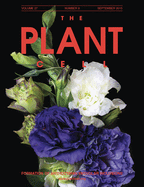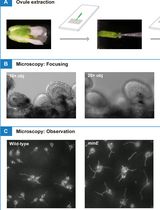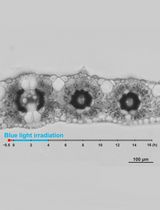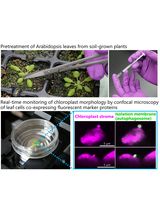- EN - English
- CN - 中文
Visualising Differential Growth of Arabidopsis Epidermal Pavement Cells Using Thin Plate Spline Analysis
使用薄板样条分析观察拟南芥铺垫表皮细胞的差异生长
发布: 2016年11月20日第6卷第22期 DOI: 10.21769/BioProtoc.2022 浏览次数: 8234
评审: Renate WeizbauerHarrie van ErpPengpeng Li
Abstract
Epidermal pavement cells in Arabidopsis leaves and cotyledons develop from relatively simple shapes to form complex cells that have multiple undulations of varying sizes. Analyzing the growth of individual parts of the cell wall boundaries over time is essential to understanding how pavement cells develop their complex shapes. Thin plate spline analysis is a method for visualizing the change of size and shape of objects through warping or deformation of a regular mesh and can be applied to understand cell wall growth. This protocol describes the application of thin plate spline analysis to visualize the development of individual pavement cells over time.
Background
Understanding the spatial pattern of growth of a cell provides insight into how plant cells form different shapes. Epidermal pavement cells of Arabidopsis thaliana cotyledons and leaves are a good model system for investigating how complex cells grow as their cell wall boundaries develop multiple undulations of different size from boundaries that were initially simple arcs (Armour et al., 2015; Fu et al., 2005). Growth of plant cells has been measured by fixing externally applied markers to cells such as algal Nitella internodes (Green et al., 1970), root cells (Shaw et al., 2000), and trichomes (Schwab et al., 2003). However measurement of cell growth from externally applied landmarks is sometimes not feasible such as when the strong fluorescence of externally applied fluorescent markers would obscure fluorescently labeled cytoskeletal elements within cells (Armour et al., 2015). Thin plate spline analysis which visualizes the changing positions of a defined number of homologous landmarks over time or between different objects has previously been used to analyze changes in the three dimensional size and shape of objects such as hominid skulls (Rosas and Bastir, 2002; Gunz et al., 2009), or the two dimensional shapes of insect wings (Börstler et al., 2014) and leaves (Polder et al., 2007). This protocol describes how to use thin plate spline analysis to visualize size and shape changes of individual cells. This technique is relatively easy to utilize on a range of cell images as it uses the input of the outline of a cell at sequential times to approximate the relative growth rate and growth direction of different areas of the cell wall.
Materials and Reagents
- Petri dish (35 x 10 mm) (SARSTEDT, catalog number: 82.1135.500 )
- 3M Micropore surgical tape 1.25 cm (3M, catalog number: 1530-0 )
- Wildtype Arabidopsis thaliana (Col-0) seeds
- Sodium hypochlorite solution (White King Premium Bleach, Woolworths, catalog number: 10006062A )
- Sterile distilled water
- Murashige and Skoog salts (Sigma-Aldrich, catalog number: M5519 )
- Sucrose (Sigma-Aldrich, catalog number: S8501 )
- OxoidTM bacteriological agar (Thermo Fisher Scientific, Thermo ScientificTM, catalog number: LP0011 )
- 1 µM solution of 3 kDa fluorescein conjugated dextran (Thermo Fisher Scientific, Molecular ProbesTM, catalog number: D3305 )
Equipment
- Sterile laminar flow hood
- Zeiss Axiophot photomicroscope (D-7082) with filter set (BP 450-490 FT 510 BP 515-565, Carl Zeiss, catalog number: 487910 )
- A 20x LD Achroplan lens with a N.A. of 0.4 (Carl Zeiss, catalog number: 421350-9970-000 [current version]; 440845-0000-000 [old version])
- an Olympus microscope digital camera (OLYMPUS, model: DP71 )
- Plant growth chamber, set at 22 °C, on a 16-h-day:8-h-night cycle
- P10, 0.5-10 μl pipette (Eppendorf, catalog number: 4920000024 )
Software
- ImageJ (available at http://imagej.nih.gov.ij)
- ImageJ macros and lookup tables (https://en-cdn.bio-protocol.org/attached/file/20161017/20161017210148_3943.rar)
- 0WillRainbow.lut
- Add-Points-From-TPSlist-To-ROImanager_.ijm
- BranchInfo-to-ROI-lines-overlay_.ijm
- Formatted-Points-List-To-ROImanager_.ijm
- TPS-rel-expansion-prepare_.ijm
- TPS-rel-expansion-format_.ijm
- ImageJ plugins
- Stack Focuser (available at http://imagej.nih.gov/ij/plugins/stack-focuser.html)
- ImageJ macros and lookup tables (https://en-cdn.bio-protocol.org/attached/file/20161017/20161017210148_3943.rar)
- tpsDig2 (available at http://life.bio.sunysb.edu/morph/)
- PAST (available at http://folk.uio.no/ohammer/past/)
- Plaintext editor (e.g., Notepad++ on Windows, TextEdit on Mac OSX or gedit on Linux)
Procedure
文章信息
版权信息
© 2016 The Authors; exclusive licensee Bio-protocol LLC.
如何引用
Armour, W. J., Barton, D. A. and Overall, R. L. (2016). Visualising Differential Growth of Arabidopsis Epidermal Pavement Cells Using Thin Plate Spline Analysis. Bio-protocol 6(22): e2022. DOI: 10.21769/BioProtoc.2022.
分类
植物科学 > 植物细胞生物学 > 细胞成像
发育生物学 > 细胞生长和命运决定
细胞生物学 > 细胞成像
您对这篇实验方法有问题吗?
在此处发布您的问题,我们将邀请本文作者来回答。同时,我们会将您的问题发布到Bio-protocol Exchange,以便寻求社区成员的帮助。
提问指南
+ 问题描述
写下详细的问题描述,包括所有有助于他人回答您问题的信息(例如实验过程、条件和相关图像等)。
Share
Bluesky
X
Copy link















